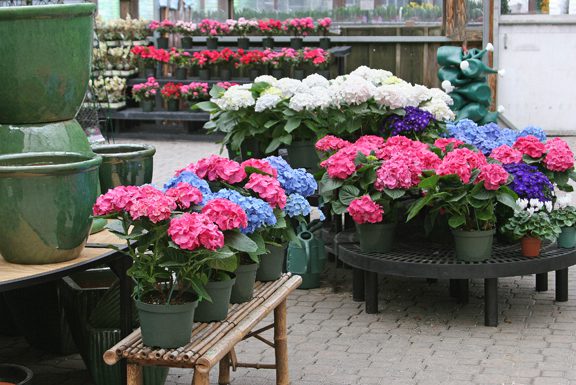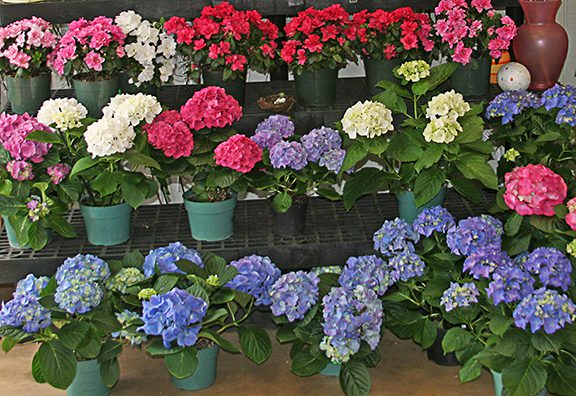Gift Hydrangeas
Gift Hydrangeas
At this time of year our greenhouse is filled with gift hydrangeas for Easter and Mother’s day. The large, colorful flowers are so beautiful it’s no wonder that this is a popular holiday plant and present. Everyone who buys or receives these plants invariably asks the same question: “Can I plant this greenhouse grown Hydrangea outside in my garden?”

The short answer is that it depends where you live. The majority of the gift hydrangeas are hardy on Cape Cod where our garden center is located. Those who live elsewhere in a warm zone 6 or zone 7 can also grow these lovely shrubs. Most gift hydrangeas (usually Hydrangea macrophylla) will thrive and bloom if grown where winter temperatures don’t go much below 5 degrees Fahrenheit.
In areas where the winter is colder the plants might survive but it’s unlikely that they will bloom. Since the flower buds are formed in the previous summer, these can get zapped by temperatures that are below 5 degrees. And if it goes below zero, unfortunately you’ll get the same number of flowers: zero.
If you want to plant your gift hydrangea, here are a few hints.
Keep the plant in a bright location indoors until all danger of frost is past. Be sure to keep the plant watered and don’t let it wilt. Some gift hydrangeas will need watering every other day. Don’t error in the opposite direction and keep the plant in standing water because this will rot the roots.
Once it’s warm enough to plant your hydrangea outside, find a location that gets at least three hours of direct sun, preferably in the morning. Hydrangeas that are shielded from hot noonday and afternoon sun keep their flowers longer.
If you’re in an area where the plant may or may not be hardy, find a location that is also sheltered from winter winds.
Amend the soil in a large area with some compost or composted cow manure. Dig this in which will also loosen the area. Plant the hydrangea in the center of this area, making sure the soil level of the plant in the pot is at ground level in the garden. (Don’t plant shrubs too high or too low.)
Water well after planting and regularly through the first summer. Since the plant will have a small root system during this first year it may dry out more quickly than established plants. Pay attention and water the hydrangea well if it starts to wilt. An inch or two of mulch spread around the plant but not pushed against the stems will help keep the soil moist.
After the first year fertilize your hydrangea with an organic fertilizer in the spring before mulching. Most white Hydrangea macrophylla will always be white but blue will remain blue in acid soils and pink will remain pink in alkaline soils.

Subscribe To Our Newsletter
Sign up for our weekly email about sales and events.
